#stata
Explore tagged Tumblr posts
Text

@unmeinoakaito
#se#sei#stata#ferita#e#hai#ancora#il#coraggio#di#essere#gentile#con#gli#altri#meriti#un#amore#più#profondo#oceano#frasi#sentimenti#vita#life#pensieri#quote#citazioni#thoughts
30 notes
·
View notes
Text
Unlocking Academic Excellence: STATA Homework Help with StatisticsHomeworkHelper.com
As an expert providing assistance for STATA homework at StatisticsHomeworkHelper.com, I have had the privilege of witnessing firsthand the transformative impact our services have on students' academic journeys. With a commitment to excellence and a passion for empowering learners, our team goes above and beyond to ensure that every student receives the support they need to excel in their STATA assignments.
Help with STATA homework isn't just about providing answers; it's about guiding students through the intricacies of data analysis, statistical modeling, and interpretation. From the moment students reach out to us for assistance, we prioritize understanding their unique challenges and learning objectives. Whether they're grappling with basic syntax or tackling complex econometric analyses, we tailor our approach to meet their specific needs, ensuring that they not only complete their assignments but also deepen their understanding of STATA and its applications.
One of the cornerstones of our approach at StatisticsHomeworkHelper.com is our team of expert tutors, who bring a wealth of knowledge and experience to the table. With backgrounds in statistics, economics, social sciences, and other related fields, they possess the expertise needed to tackle even the most challenging STATA assignments with confidence. What sets our tutors apart is their ability to communicate complex concepts in a clear and concise manner, making them accessible to students of all levels of proficiency.
When it comes to helping students with their STATA homework, our goal is to empower them to become independent and self-sufficient learners. Rather than simply providing solutions, we guide students through the problem-solving process, encouraging them to think critically, analyze data effectively, and interpret results accurately. By fostering a deep understanding of STATA's capabilities and limitations, we equip students with the skills and confidence they need to succeed in both academic and professional settings.
At StatisticsHomeworkHelper.com, we understand the importance of deadlines and the pressure that students face to submit their assignments on time. That's why we prioritize promptness and reliability in our service delivery. Whether students are working on short-term assignments or long-term projects, they can trust our team to deliver high-quality solutions within the agreed-upon timeframe. This level of reliability not only reduces stress for students but also allows them to focus their time and energy on other academic pursuits.
In addition to our commitment to academic excellence, we also prioritize personalized support and attention for every student we work with. We recognize that every student has unique strengths, weaknesses, and learning styles, and we tailor our approach accordingly. Whether students prefer one-on-one tutoring sessions, email support, or live chat assistance, we are here to provide the guidance and encouragement they need to succeed.
As someone who has had the privilege of working as an expert for StatisticsHomeworkHelper.com, I can attest to the impact our services have on students' academic success. Whether students are struggling to grasp the basics of STATA or seeking assistance with advanced statistical techniques, our team is here to help. With our unwavering commitment to excellence, personalized support, and unmatched expertise, we are proud to be a trusted partner in students' educational journeys.
In conclusion, if you're looking for help with STATA homework, look no further than StatisticsHomeworkHelper.com. Our team of expert tutors is dedicated to helping students succeed, providing personalized support, and empowering them to achieve their academic goals. With our commitment to excellence and reliability, we are here to support students every step of the way.
2 notes
·
View notes
Text

Listed below are the “Power Stats” of Night Shift. They have no in-game purpose, only listed on the character cards that came with every Skylander figure until the release of Skylanders: SuperChargers:
Strength: 180
Defense: 100
Agility: 145
Luck: 45
#Skylanders#Skylanders Swap Force#Undead Skylanders#Swap Force Characters#Playable Characters#SWAP Force Skylanders#Male Skylanders#Teleport Swappers#Vampires#Undead Characters#Night Shift#Stata#Power Stats
8 notes
·
View notes
Text
Checkout my bio
#study #math #statistics #pythonprogramming #microsoftexcel #msexcel #Rstudio #spss #STATA #matlab #mathlab

#maths#mathskills#statistics#rstudio#stata#spss assignment help#matlab#ms excel#microsoft excel#pythonprogramming#pythonprojects
0 notes
Text
5 Alternatif SPSS untuk Analisis Statistik
Photo by Pavel Danilyuk on Pexels.com Di tengah ledakan data dan kebutuhan analisis yang semakin kompleks, SPSS telah lama menjadi andalan para peneliti dan praktisi dalam analisis statistik. Namun, tidak semua institusi atau individu mampu mengakses lisensi komersial yang cukup mahal atau merasa nyaman dengan antarmuka tradisional SPSS. Untungnya, ada sejumlah alternatif—baik open-source maupun…

View On WordPress
0 notes
Text
Monitoring, Evaluation, Research, and Learning (MERL) Manager Opportunity in South Sudan - February 2025
Plan International is seeking a highly skilled and experienced MERL Manager to join their team in Juba, South Sudan. This is a crucial role for driving data-driven decision-making and ensuring program effectiveness. About Plan International: Plan International is a global development and humanitarian organization dedicated to advancing children’s rights and equality for girls. They work in…

View On WordPress
#Africa Jobs#ArcGIS#Data Analysis Jobs#Development Jobs#Grant Management#Humanitarian Jobs#International Development Jobs#Job Opportunities SS#Juba Jobs#MERL Jobs#Monitoring Evaluation Research Learning#NGO Jobs#Plan International#Program Management Jobs#Proposal Writing#Research Jobs#South Sudan Careers#South Sudan Jobs#SPSS#STATA
0 notes
Text
Optimizing Memory Allocation for Large Data in Stata Assignments
When you start learning about statistics and econometrics, especially when doing Stata assignments, managing memory effectively is very important. Stata is a great tool for analyzing data, but when working with large datasets, you might face issues like, “How can I make sure it runs smoothly?” or “Can I pay someone to do my Stata assignment because it keeps crashing?” Don’t worry—we’re here to explain how to optimize memory and help you succeed with your Stata tasks.
Why Understanding Memory Allocation Matters When Working on Stata Assignments

Efficient data processing in Stata relies on how well its memory works. When you work with big datasets with thousands or millions of records, wrong memory use can lead to both slow processing and unstable program behavior. For students seeking Stata assignment help, mastering memory settings is the difference between frustration and a smooth workflow. Understanding how Stata manages memory is a challenging topic, but you'll find it’s more straightforward than it seems. Stata only gives your data a limited amount of memory when you start working with it. Default settings work well for basic data work, but they won't give you enough memory when you need to process large economic data analyzing economic indicators or panel data with numerous time points.
Getting Started: How Stata Allocates Memory
Before we talk about ways to make things work better, let’s first see how STATA uses memory:
Memory for data: STATA stores your datasets in the computer’s RAM. This means if your dataset is big, it requires more memory.
Sort order and temporary files: Some stata commands, like sorting data, creates temporary copies of your dataset. This can use up even more memory.
Matsize setting: This decides how big the matrices (used in calculations) can be in memory. If you’re running models like regression with lots of variables and the matsize is too small, you might get errors.
Step-by-Step Guide to Optimize Memory Allocation in Stata Assignments
1. Increase the Memory Available to Stata Without Overloading Your System
To set memory parameters for Stata, enter "set memory." For instance:
set memory 2g
The command here lets Stata use 2GB of RAM memory. Just remember that running Stata takes space from other programs running on your computer, so adjust usage carefully. When you have a big project to work on, understanding exactly how much space your data takes up is the key. The describe command helps you learn about the memory usage of variables in your dataset. If needed, you can compress your dataset to save space:
compress
The command shrinks variable storage requirements, keeping previous levels of accuracy while freeing up room on your computer for other work.
2. Avoid Common Memory Bottlenecks by Managing Temporary Files
Memory use rises quickly when commands merge and append run on big datasets. Separate your operations into smaller tasks to prevent slowdowns. For example:
merge 1:1 id using dataset1_part1, nogenerate
Datasets can be divided into chunks before merging minimizes memory strain.
3. Change Matsize Setting When You Work With Big Data Models
Changing the matsize command lets you control how big your matrices stay in RAM. You need to adjust matsize when your model includes multiple predictor variables. For example:
set matsize 800
This command increases the matrix size limit to to 800, stopping regressions from crashing. Remember not to overdo, since it takes up more memory space.
4. Optimize Data Storage Formats to Minimize Memory Usage
Stata allows you to store variables having sizes of minimum of one byte storage (byte) up to maximum of eight bytes (double). When your data fits smaller types, don't use larger ones. It conserves memory on your computer. When a variable's values fall between 0 and 255, changing its storage from an int or float to byte saves valuable computer space.
Here’s how you can check and adjust variable types: compress
Or manually change variable types: generate byte age_group = age
Advice for Students Looking for Stata Assignment Help
If dealing with memory allocation feels too difficult, it’s okay to ask for help from experts. Whether you’re wondering, “How can I finish my Stata assignment without mistakes?” or “Can I hire someone to do my Stata assignment?” learning these ideas will help you work better with tutors or assignment helpers.
Keep in mind, improving memory allocation isn’t just about finishing your assignment; it’s a valuable skill that can make you stand out in data-driven jobs. If you ever feel stuck, Stata’s detailed guides and online communities are great places to find help.
Conclusion: Mastering Memory Allocation for Seamless Stata Assignments
By learning how to handle memory in Stata, you’re not only solving your current assignments but also preparing for bigger data analysis tasks. From adjusting `set memory` and `set matsize` to shrinking datasets, these methods keep your work efficient and stress-free. If you get stuck, professional Stata assignment help can guide you through the complexities, leaving you with more time to focus on insights rather than errors. Start using these strategies, play with Stata's features, and see how your work becomes better and better.
0 notes
Text

🔍 Exploratory vs. Confirmatory Factor Analysis – Understand the key differences between these statistical methods! 📊 Our STATA assignment help experts are here to guide you with precise analysis and interpretation. Need help? Do my STATA homework is just a click away! 👇
https://www.tutorhelpdesk.com/homeworkhelp/Statistics-/STATA-Assignment-Help.html
0 notes
Text
Here we have the best ever comparison between SPSS vs Stata. Lets have a look on the deep comparison between SPSS vs Stata.
0 notes
Photo

PRIMA PAGINA Gazzetta Del Sud Messina di Oggi venerdì, 23 agosto 2024
#PrimaPagina#gazzettadelsudmessina quotidiano#giornale#primepagine#frontpage#nazionali#internazionali#news#inedicola#oggi affida#alla#santa#arrestato#tentato#omicidio#avvenuto#luglio#termine#concerto#stata#aggredita#aver#respinto#avances#acqua#messina#vista#amministrazione#ottimista#vicina
0 notes
Text
Monsoon Arrives in Jharkhand, Bringing Relief from Heat
Weather department predicts good rainfall across 24 districts in coming days Temperature drop expected as southwest monsoon advances through the state. RANCHI – The southwest monsoon has officially entered Jharkhand, including the Kolhan region, on Friday, according to Dr. Abhishek Anand, meteorologist at the Ranchi center. "We expect the monsoon to expand further in the coming days, with good…

View On WordPress
#राज्य#Bay of Bengal weather system#Dr. Abhishek Anand meteorologist#Jamshedpur weather update#Jharkhand agriculture monsoon impact#Jharkhand district rainfall predictions#Jharkhand monsoon arrival#Jharkhand temperature drop#Kolhan region rainfall#Ranchi weather center forecast#southwest monsoon advance India#STATA
1 note
·
View note
Text

1 note
·
View note
Text
Panel VAR in Stata and PVAR-DY-FFT
Preparation
xtset pros mm (province, month)
Endogenous variables:
global Y loan_midyoy y1 stock_pro
Provincial medium-term loans year-on-year (%)
Provincial 1-year interest rate (%) (NSS model estimate, not included in this article) (%)
provincial stock return
Exogenous variables:
global X lnewcasenet m2yoy reserve_diff
Logarithm of number of confirmed cases
M2 year-on-year
reserve ratio difference
Descriptive statistics:
global V loan_midyoy y1 y10 lnewcasenet m2yoy reserve_diff sum2docx $V using "D.docx", replace stats(N mean sd min p25 median p75 max ) title("Descriptive statistics")
VarName Obs Mean SD Min P25 Median P75 Max
loan_midyoy 2232 13.461 7.463 -79.300 9.400 13.400 16.800 107.400
y1 2232 2.842 0.447 1.564 2.496 2.835 3.124 4.462
stock_pro 2232 0.109 6.753 -24.485 -3.986 -0.122 3.541 73.985
lnewcasenet 2232 1.793 2.603 0.000 0.000 0.000 3.434 13.226
m2yoy 2232 0.095 0.012 0.080 0.085 0.091 0.105 0.124
reserve_diff 2232 -0.083 0.232 -1.000 0.000 0.000 0.000 0.000
Check for unit root:
foreach x of global V { xtunitroot ips `x',trend }
Lag order
pvarsoc $Y , pinstl(1/5)
pvaro(instl(4/8)): Specifies to use the fourth through eighth lags of each variable as instrumental variables. In this case, in order to deal with endogeneity issues, relatively distant lags are chosen as instrumental variables. This means that when estimating the model, the current value of each variable is not directly affected by its own recent lagged value (first to third lag), thus reducing the possibility of endogeneity.
pinstl(1/5): Indicates using lags from the highest lag to the fifth lag as instrumental variables. Specifically, for the PVAR(1) model, the first to fifth lags are used as instrumental variables; for the PVAR(2) model, the second to sixth lags are used as instrumental variables, and so on. The purpose of this approach is to provide each model variable with a set of instrumental variables that are related to, but relatively independent of, its own lag structure, thereby helping to address endogeneity issues.
CD test (Cross-sectional Dependence Test): This is a test to detect whether there is cross-sectional dependence (ie, correlation between different individuals) in panel data. Values close to 1 generally indicate the presence of strong cross-sectional dependence. If there is cross-sectional dependence in the data, cluster-robust standard errors can be used to correct for this.
J-statistic: The J-statistic that detects model over-identification of constraints and is usually related to the effectiveness of instrumental variables.
J pvalue: The p value of the J statistic, used to determine whether the instrumental variable is valid. A low p-value (usually less than 0.05) means that at least one of the instrumental variables is probably not applicable.
MBIC, MAIC, MQIC: These are different information criterion values, used for model selection. Lower values generally indicate a better model.
MBIC: Bayesian Information Criterion.
MAIC: Akaike Information Criterion.
MQIC: Quantile information criterion.

Interpretation: The p-values of the J-test are 0.00 and 0.63 for Lag 1 and Lag 2 respectively. The p-value for the first lag is very low, indicating possible instrumental variable inefficiency. The p-value for the second lag is higher, indicating that instrumental variables may be effective. In this example, Lag 2 seems to be the optimal choice because its MBIC, AIC, and MQIC values are relatively low. However, it should be noted that the CD test shows that there is cross-sectional dependence, which may affect the accuracy of model estimation.
Model estimation:
pvar $Y, lags(2) instlags(1/4) fod exog($X) gmmopts(winitial(identity) wmatrix(robust) twostep vce(cluster pros))
pvar: This is the Stata command that calls the PVAR model.
$Y: These are the endogenous variables included in the model.
$X: These are exogenous variables included in the model.
lags(2): Specifies to include 2-period lags for each variable in the PVAR model.
number of lag periods for the variable
instlags(1/4): This is the number of lags for the specified instrumental variable. Here, it tells Stata to use the first to fourth lags as instrumental variables. This is to address possible endogeneity issues, i.e. possible interactions between variables in the model.
Lag order selection criteria:
Information criterion: Statistical criteria such as AIC and BIC can be used to judge the choice of lag period.
Diagnostic tests: Use diagnostic tests of the model (e.g. Q(b), Hansen J overidentification test) to assess the appropriateness of different lag settings.
fod/fd: medium fixed effects.
fod: The Helmert transformation is a forward mean difference method that compares each observation to the mean of its future observations. This method makes more efficient use of available information than simple difference-in-difference methods when dealing with fixed effects, especially when the time dimension of panel data is short.
A requirement of the Helmert transformation on the data is that the panel must be balanced (i.e., for each panel unit, there are observations at all time points).
fd: Use first differences to remove panel-specific fixed effects. In this method, each observation is subtracted from its observation in the previous period, thus eliminating the influence of time-invariant fixed effects. First difference is a common method for dealing with fixed effects in panel data, especially when there is a trend or horizontal shift in the data over time.
Usage Scenarios and Choices: If your panel data is balanced and you want to utilize time series information more efficiently, you may be inclined to use the Helmert transformation. First differences may be more appropriate if the data contain unbalanced panels or if there is greater concern with removing possible time trends and horizontal shifts.
exog($X): This option is used to specify exogenous variables in the model. Exogenous variables are assumed to be variables that are not affected by other variables in the model.
gmmopts(winitial(identity) wmatrix(robust) twostep vce(cluster pros))
winitial(identity): Set the initial weight matrix to the identity matrix.
wmatrix(robust): Use a robust weight matrix.
twostep: Use the two-step GMM estimation method.
vce(cluster pros): Specifies the standard error of clustering robustness, and uses `pros` as the clustering variable.
GMM criterion function

Final GMM Criterion Q(b) = 0.0162: The GMM criterion function (Q(b)) is a mathematical expression that measures how consistent your model parameter estimates (b) are with these moment conditions. Simply put, it measures the gap between model parameters and theoretical or empirical expectations.
is a vector of moment conditions. These moment conditions are a series of assumptions or constraints set based on the model. They usually come in the form of expected values (expectations) that represent the conditions that the model parameter b should satisfy.
W is a weight matrix used to assign different weights to different moment conditions.
b is a vector of model parameters. The goal of GMM estimation is to find the optimal b to minimize Q(b).
No. of obs = 2077: This means there are a total of 2077 observations in the data set.
No. of panels = 31: This means that the data set contains 31 panel units.
Ave. no. of T = 67.000: Each panel unit has an average of 67 time point observations.
Coefficient interpretation (not marginal effects)
L1.loan_midyoy: 0.8034088: When the one-period lag of loan_midyoy increases by one unit, the current period's loan_midyoy is expected to increase by approximately 0.803 units. This coefficient is statistically significant (p-value 0.000), indicating that the one-period lag has a significant positive impact on the current value.
L2.loan_midyoy: 0.1022556: When the two-period lag of loan_midyoy increases by one unit, the current period's loan_midyoy is expected to increase by approximately 0.102 units. This coefficient is not statistically significant (p-value of 0.3), indicating that the effect of the two-period lag on the current value may not be significant.

overidentification test
pvar $Y, lags(2) instlags(1/4) fod exog($X) gmmopts(winitial(identity) wmatrix(robust) twostep vce(cluster pros)) overid (written in one line)

Statistics: Hansen's J chi2(18) = 24.87 means that the chi-square statistic value of the Hansen J test is 24.87 and the degrees of freedom are 18.
P-value: (p = 0.137) means that the p-value of this test is 0.129. Since the p-value is higher than commonly used significance levels (such as 0.05 or 0.01), this indicates that there is insufficient evidence to reject the null hypothesis. In the Hansen J test, the null hypothesis is that all instrumental variables are exogenous, that is, they are uncorrelated with the error term. Instrumental variables may be appropriate.
Stability check:
pvarstable

Eigenvalues: Listed eigenvalues include their real and imaginary parts. For example, 0.9271743 is a real eigenvalue. 0.0337797±0.326651i is a pair of conjugate complex eigenvalues.
Modulus: The module of an eigenvalue is its distance from the origin on the complex plane. It is calculated as the square root of the sum of the squares of the real and imaginary parts.
Stability condition: The stability condition of the PVAR model requires that the modules of all eigenvalues must be less than or equal to 1 (that is, all eigenvalues are located within the unit circle).
Granger causality:
pvargranger
Ho (null hypothesis): The excluded variable is not a Granger cause (i.e. does not have a predictive effect on the variables in the equation).
Ha (alternative hypothesis): The excluded variable is a Granger cause (i.e. has a predictive effect on the variables in the equation).

For the stock_pro equation:
loan_midyoy: chi2 = 6.224 (degrees of freedom df = 2), p-value = 0.045. There is sufficient evidence to reject the null hypothesis, indicating that loan_midyoy is the Granger cause of stock_pro.
y1: chi2 = 0.605 (degrees of freedom df = 2), p-value = 0.739. There is insufficient evidence to reject the null hypothesis indicating that y1 is not the Granger cause of stock_pro.
Margins:
The PVAR model involves the dynamic interaction of multiple endogenous variables, which means that the current value of a variable is not only affected by its own past values, but also by the past values of other variables. In this case, the margins command may not be suitable for calculating or interpreting the marginal effects of variables in the model, because these effects are not fixed but change dynamically with time and the state of the model. The following approaches may be considered:
Impulse response analysis
Impulse response analysis: In the PVAR model, the more common analysis method is to perform impulse response analysis (Impulse Response Analysis), which can help understand how the impact of one variable affects other variables in the system over time.
pvarirf,oirf mc(200) tab
Orthogonalized Impulse Response Function (OIRF): In some economic or financial models, orthogonalized processing may be more realistic, especially when analyzing policy shocks or other clearly distinguished externalities. During impact. If the shocks in the model are assumed to be independent of each other, then OIRF should be used. Orthogonalization ensures that each shock is orthogonal (statistically independent) through a mathematical process (such as Cholisky decomposition). This means that the effect of each shock is calculated controlling for the other shocks.
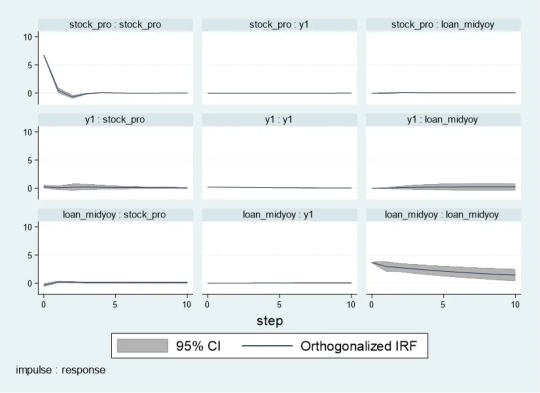
When stock_pro is subject to a positive shock of one standard deviation, loan_midyoy is expected to decrease slightly in the first period, with a specific response value of -0.0028833, indicating that loan_midyoy is expected to decrease by approximately 0.0029 units.
This effect gradually changes over time. For example, in the second period, the shock response of loan_midyoy to stock_pro is 0.0700289, which means that loan_midyoy is expected to increase by about 0.0700 units.
pvarirf, mc(200) tab
For some complex dynamic systems, non-orthogonalized IRF may be better able to capture the actual interactions between variables within the system. Non-orthogonalized impulse response function: If you do not make the assumption that the shocks are independent of each other, or if you believe that there is some inherent interdependence between the variables in the model, you may choose a non-orthogonalized IRF.
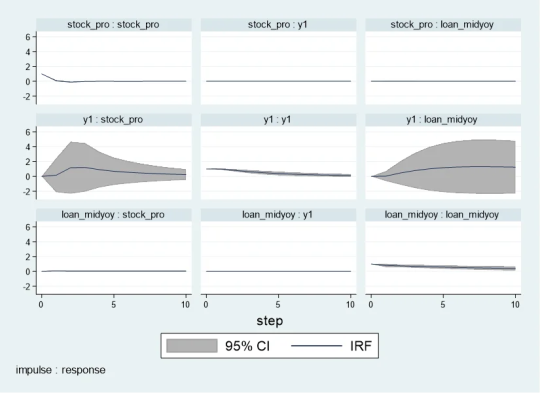
When stock_pro is impacted: In period 1, loan_midyoy has a slightly negative response to the impact on stock_pro, with a response value of -0.0004269.
This effect gradually changes over time. For example, in period 2, the response value is 0.0103697, indicating that loan_midyoy is expected to increase slightly.
Forecast error variance decomposition
Forecast Error Variance Decomposition is also a useful tool for analyzing the dynamic relationship between variables in the PVAR model.
Time point 0: The contribution of all variables is 0, because at the initial moment when the impact occurs, no variables have an impact on loan_midyoy.
Time point 1: The forecast error variance of loan_midyoy is completely explained by its own shock (100%), while the contribution of y1 and stock_pro is 0.
Subsequent time points: For example, at time point 10, about 99.45% of the forecast error variance of loan_midyoy is explained by the shock to loan_midyoy itself, about 0.52% is explained by the shock to y1, and about 0.03% is explained by the shock to stock_pro.

Diebold-Yilmaz (DY) variance decomposition
Diebold-Yilmaz (DY) variance decomposition is an econometric method used to quantify volatility spillovers between variables in time series data. This approach is based on the vector autoregressive (VAR) model, which is used particularly in the field of financial economics to analyze and understand the interaction between market variables. The following are the key concepts of DY variance decomposition:
basic concepts
VAR model: The VAR model is a statistical model used to describe the dynamic relationship between multiple time series variables. The VAR model assumes that the current value of each variable depends not only on its own historical value, but also on the historical values of other variables.
Forecast error variance decomposition (FEVD): In the VAR model, FEVD analysis is used to determine what proportion of the forecast error of a variable can be attributed to the impact of other variables.
Volatility spillover index: The volatility spillover index proposed by Diebold and Yilmaz is based on FEVD, which quantifies the contribution of the fluctuation of each variable in a system to the fluctuation of other variables.
"From" and "to" spillover: DY variance decomposition distinguishes between "from" and "to" spillover effects. "From" spillover refers to the influence of a certain variable on the fluctuation of other variables in the system; while "flow to" spillover refers to the influence of other variables in the system on the fluctuation of that specific variable.
Application
Financial market analysis: DY variance decomposition is particularly important in financial market analysis. For example, it can be used to analyze the fluctuation correlation between stock markets in different countries, or the extent of risk spillovers during financial crises.
Policy evaluation: In macroeconomic policy analysis, DY analysis can help policymakers understand the impact of policy decisions (such as interest rate changes) on various areas of the economy.
Precautions
Explanation: DY analysis provides a way to quantify volatility spillover, but it cannot be directly interpreted as cause and effect. The spillover index reflects correlation, not causation, of fluctuations.
Model setting: The effectiveness of DY analysis depends on the correct setting of the VAR model, including the selection of variables, the determination of the lag order, etc.
mat list e(Sigma)

mat list e(b)

Since I have previously made a DY model suitable for variable coefficients, I only need to fill in the time-varying coefficients in the first period. Because when there is only one period, the results of the constant coefficient and the variable coefficient are the same.
Since stata does not have the original code of dy, R has the spillover package, which can be modified without errors. Therefore, the spillover package of R language is recommended. It is taken from the code in bk2018 article.
Therefore, you need to manually fill in the stata coefficients into the interface part I made in R language, and then continue with the BK code.
```{r} library(tvpfft) library(tvpgevd) library(tvvardy) library(ggplot2) library(gridExtra) a = rbind(c(0,.80340884 , .02610899, -.00042695, .10225563, .39926325, .01073319 ), c(0, .00269745, .97914619, .00044023, .00063315, -.16136799, -.00038024), c(0, .06798046, .1483059 , .07497919, -.02856828, 1.0076676, -.10757831)) ``` ```{r} Sigma = rbind(c( 13.495069, .01625753, -1.3143064), c( .01625753, .03064462, .04350408 ), c( -1.3143064, .04350408, 45.800811)) df=data.frame(t(c(1,1,1))) colnames(df)=c("loan_midyoy","y1","stock_pro") fit = list() fit$Beta.postmean=array(dim =c(3,7,1)) fit$H.postmean=array(dim =c(3,3,1)) fit$Beta.postmean[,,1]=a fit$H.postmean[,,1]=Sigma fit$M=3tvp.gevd(fit, 37, df) ```
Diagonal line (loan_midyoy vs. loan_midyoy, y1 vs. y1, stock_pro vs. stock_pro): shows that the main source of fluctuations in each variable is its own fluctuation. For example, 98.52% of loan_midyoy's fluctuations are caused by itself.
Off-diagonal lines (such as the y1 and stock_pro rows of the loan_midyoy column): represent the contribution of other variables to the loan_midyoy fluctuations. In this example, y1 and stock_pro contribute very little to the fluctuation of loan_midyoy, 1.37% and 0.11% respectively.
The "From" row: shows the overall contribution of each variable to the fluctuations of all other variables. For example, the total contribution of loan_midyoy to the fluctuation of all other variables in the system is 0.49%.
"To" column: reflects the overall contribution of all other variables in the system to the fluctuation of a single variable. For example, the total contribution of other variables in the system to the fluctuation of loan_midyoy is 5.30%.
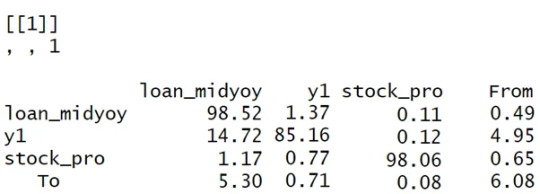
Analysis and interpretation:
Self-contribution: The fluctuations of loan_midyoy, y1, and stock_pro are mainly caused by their own shocks, which can be seen from the high percentages on their diagonals.
Mutual influence: y1 and stock_pro contribute less to each other's fluctuations, but y1 has a relatively large contribution to the fluctuations of loan_midyoy (14.72%).
System Fluctuation Impact: The “From” and “To” columns provide an overall measure of spillover effects. For example, stock_pro has a small contribution to the fluctuation of the system (0.65% comes from the impact of stock_pro), but the system has a greater impact on the fluctuation of stock_pro (6.08% of the fluctuation comes from the system).```{r} tvp.gevd.fft(fit, df, c(pi+0.00001,pi/12,0),37) ```
The same goes for Fourier transform. It is divided into those within 1 year and 1-3 years, and the sum is the previous picture.
DY I used the R language's spillover package to modify the interface.
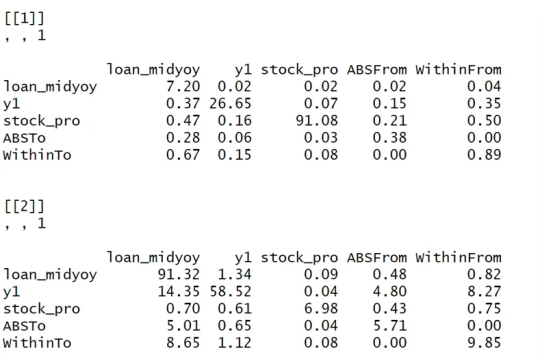
Part of the code logic:
function (ir1, h, Sigma, df) { ir10 <- list() n <- length(Sigma[, 1]) for (oo in 1:n) { ir10[[oo]] <- matrix(ncol = n, nrow = h) for (pp in 1:n) { rep <- oo + (pp - 1) * (n) ir10[[oo]][, pp] <- ir1[, rep] } } ir1 <- lapply(1:(h), function(j) sapply(ir10, function(i) i[j, ])) denom <- diag(Reduce("+", lapply(ir1, function(i) i %*% Sigma %*% t(i)))) enum <- Reduce("+", lapply(ir1, function(i) (i %*% Sigma)^2)) tab <- sapply(1:nrow(enum), function(j) enum[j, ]/(denom[j] * diag(Sigma))) tab0 <- t(apply(tab, 2, function(i) i/sum(i))) assets <- colnames(df) n <- length(tab0[, 1]) stand <- matrix(0, ncol = (n + 1), nrow = (n + 1)) stand[1:n, 1:n] <- tab0 * 100 stand2 <- stand - diag(diag(stand)) stand[1:(n + 1), (n + 1)] <- rowSums(stand2)/n stand[(n + 1), 1:(n + 1)] <- colSums(stand2)/n stand[(n + 1), (n + 1)] <- sum(stand[, (n + 1)]) colnames(stand) <- c(colnames(df), "From") rownames(stand) <- c(colnames(df), "To") stand = round(stand, 2) return(stand) }
0 notes
Text
olahdatasemarang
https://m.facebook.com/reel/309097238763600
#olahdtasemarang2023 #olahdatasemarang2024 #olahdtasemarang_2023 #olahdatasemarang_2024 #olahdata #skripsi #spss #stata #eviews #smartpls
0 notes
Text


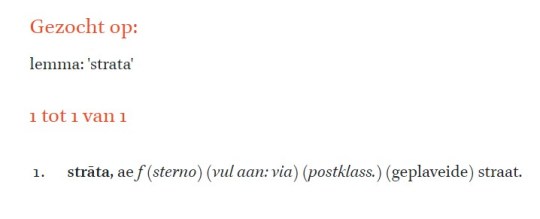
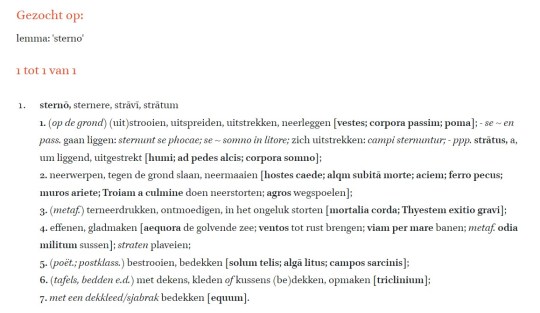




Valse vrienden straat [geplaveide weg] en straat [zee-engte].
0 notes